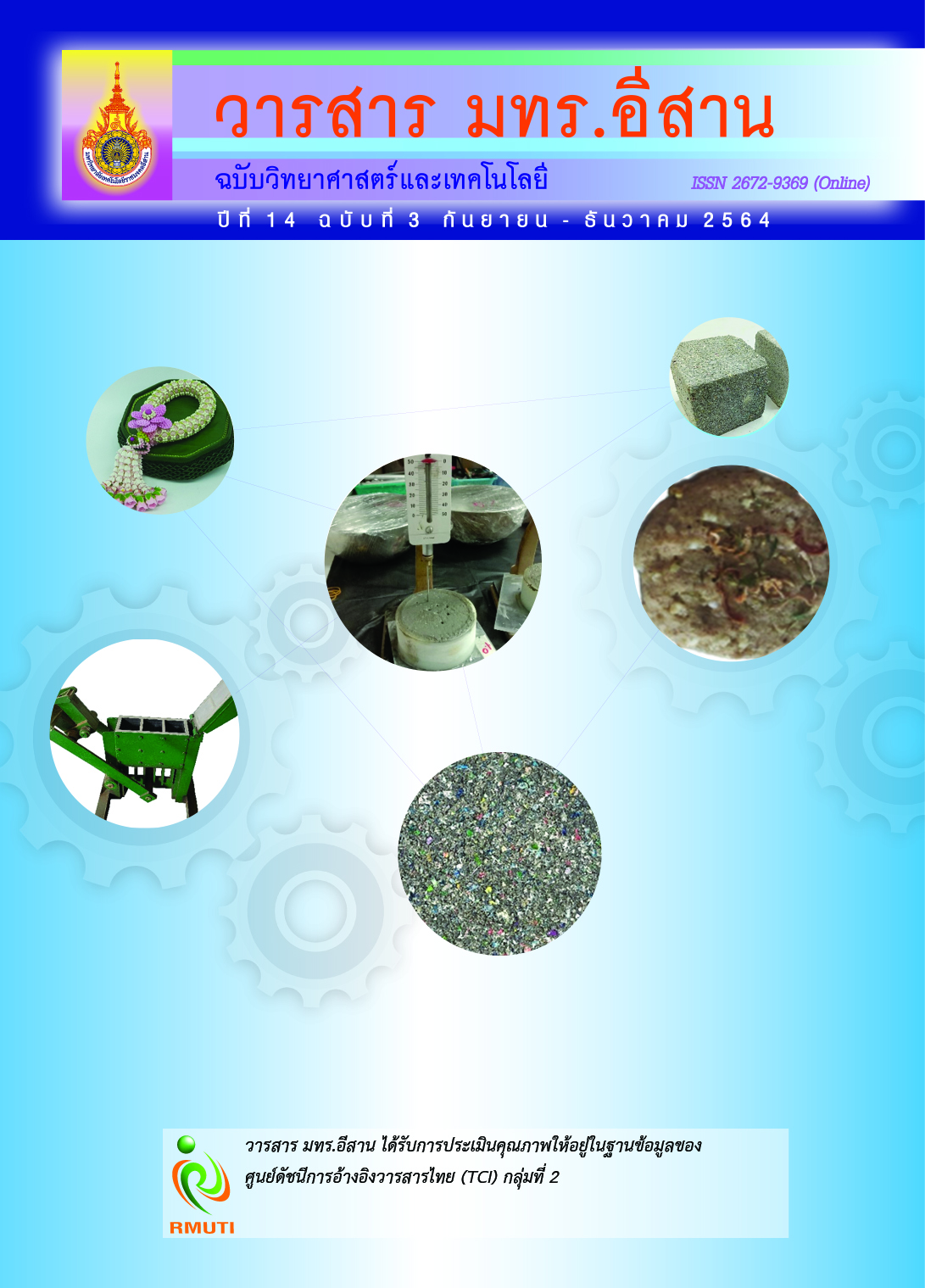Influence of Ordinary Portland Cement and Different Alkali Solution Ratio in Geoplolymer Mortar on Time of Setting and Compressive Strength for use as A Repaired Materails
Main Article Content
Abstract
This research aims to study the time of setting, compressive strength, and slent shear strength of high-calcium fly ash geopolymer mortar contaimning ordinary portland cement. The high-calcium fly ash was used as binder and replaced with ordinary portland cement of 0 and 20 wt%. 10 molar sodium hydroxide solution and sodium silicate solution were used as alkali activated solution for leaching fly ash. The ratio of sodium silicate solution to sodium hydroxide solution was adjusted to 1.0, 1.5, 2.0 and 2.5 by weight. The liquid-to-binder ratio is 0.60 and the geopolymerization is not activated with high temperature. The results show ordinary portland cement and an increase in the ratio of sodium silicate solution to sodium hydroxide solution can clearly accelerate time of setting of geopolymer mortars, and the compressive strength can increase up to 66.1 MPa. In addition, it was found that the adhesion between the cement system and the geopolymer system corporated with the cement system was better than that of the cement system alone.
Article Details
References
Phoo-ngernkham, T., Hanjitsuwan, S., Suksiripattanapong, C., Thumrongvut, J., Suebsuk, J., and Sookasem, S. (2016). Flexural Strength of Notched Concrete Beam Filled with Alkali-Activated Binders Under Different Types of Alkali Solutions. Construction and Building Materials. Vol. 127, pp. 673-678. DOI: 10.1016/j.conbuildmat.2016.10.053
Chindaprasirt, P., Chareerat, T., and Sirivivatnanon, V. (2007). Workability and Strength of Coarse High Calcium Fly Ash Geopolymer. Cement and Concrete Composites. Vol. 29, Issue 3, pp. 224-229. DOI: 10.1016/j.cemconcomp.2006.11.002
Pangdaeng, S., Phoo-ngernkham, T., Sata, V., and Chindaprasirt, P. (2014). Influence of Curing Conditions on Properties of High Calcium Fly Ash Geopolymer Containing Portland Cement as Additive. Materials and Design. Vol. 53, pp. 269-274. DOI: 10.1016/j.matdes.2013.07.018
Palomo, A., Fernández-Jiménez, A., Kovalchuk, G., Ordoñez, L. M., and Naranjo, M. C. (2007). Opc-Fly Ash Cementitious Systems: Study of Gel Binders Produced During Alkaline Hydration. Journal of Materials Science. Vol. 9, pp. 2958-2966. DOI: 10.1007/s10853-006-0585-7
Hanjitsuwan, S., Hunpratub, S., Thongbai, P., Maensir, S., Sata, V., and Chindaprasirt, P. (2014). Effects of NaOH Concentrations on Physical and Electrical Properties of High Calcium Fly Ash Geopolymer Paste. Cement and Concrete Composites. Vol. 45, pp. 9-14. DOI: 10.1016/j.cemconcomp.2013.09.012
Pacheco-Torgal, F., Castro-Gomes, J. P., and Jalali, S. (2008). Adhesion Characterization of Tungsten Mine Waste Geopolymeric Binder. Influence of OPC Concrete Substrate Surface Treatment. Construction and Building Materials. Vol. 22, Issue 3, pp. 154-161. DOI: 10.1016/j.conbuildmat.2006.10.005
Songpiriyakij, S., Pulngern, T., Pungpremtrakul, P., and Jaturapitakkul, C. (2011). Anchorage of Steel Bars in Concrete by Geopolymer Paste. Materials and Design. Vol. 32, Issue 5, pp. 3021-3028. DOI: 10.1016/j.matdes.2011.01.048
Thumrongvut, J., Seangatith, S., and Kumlue, K. (2013). Tests on Structural Behaviors of Precast Partially-Prestressed Concrete Beam's Joints. RMUTI JOURNAL Science and Technology. Vol. 6, No. 2, pp. 15-30 (In Thai)
ASTM C191-13. (2013). Standard Test Method for Time of Setting of Hydrualic Cement by Vicat Needle. Annual Book of ASTM Standard. Vol.04.01. Philadelphia
ASTM C109. (2002). Standard Test Method of Compressive Strength of Hydrualic Cement Mortars (Using 2-in. or [50 mm] cube speciments). Annual Book of ASTM Standard. Vol.04.01. Philadelphia
ACI 211.1-91. (1991). Standard Practice for Selecting Proportions for Normal, Heavyweight, and Mass Concrete. American Concrete Institute
Phoo-ngernkham, T., Maegawa, A., Mishima, N., Hatanaka, S., and Chindaprasirt, P. (2015). Effects of Sodium Hydroxide and Sodium Silicate Solutions on Compressive and Shear Bond Strengths of FA-GBFS Geopolymer. Construction and Building Materials. Vol. 91, pp. 1-8. DOI: 10.1016/j.conbuildmat.2015.05.001
Phoo-ngernkham, T., Sata, V., Hanjitsuwan, S., Ridtirud, C., Chindaprasirt P., and Hatanaka, S. (2015). High Calcium Fly Ash Geopolymer Mortar Containing Portland Cement for use as Repair Material. Construction and Building Materials. Vol. 98, pp. 482-428. DOI: 10.1016/j.conbuildmat.2015.08.139
ASTM C882. (2005). Standard Test Method for Bond Strength of Epoxy-Resin Systems Used with Concrete by Slant Shear. Annual Book of ASTM Standard. Philadelphia
Phoo-ngernkham, T., Chindaprasirt, P., Sata, V., Pangdaeng, S., and Sinsiri, T. (2015). Properteis of High Calcium Fly Ash Geopolymer Pastes Containing Portland Cement as Additive. International Journal of Minerals, metallurgy and Materials. Vol. 20, No. 2, pp. 214-220. DOI: 10.1007/s12613-013-0715-6
Phoo-ngernkham, T., Hanjitsuwan, S., Li, L. Y., Damrongwiriyanupap, N., and Chindaprasirt, P. (2019). Adhesion Characterization of Portland Cement Concrete and Alkali-Activated Binders Under Different Types of Calcium Promoters. Advances in Cement Research. Vol. 31, Issue 2, pp. 69-79. DOI: 10.1680/jadcr.17.00122


